Many Mortises in five tables . . .
. . . but only half the number needed by crisscrossing the cross rails using a simple halving joint to level the top field ready for the tabletop. The crossing of the unifying top rails allows for added potential we don’t always see or realise. Seller’s home allows me to explore and share things that might not at first be obvious and this is what I love about the opportunity we have created. Take the new router plane, for instance. Creating a dozen and more tenons eventually will translate into followers making maybe a hundred or two if indeed they make all of the pieces. In the living room alone, over the past ten months, we have made 100 mortise and tenon joints, 20 sets of dovetails, and about the same in housing dadoes. I can’t imagine making the 120 joints that needed the router-plane refining capacity. I kept telling myself, “But not everyone has the luxury of owning a good router plane!” I had to do something and now it’s done.
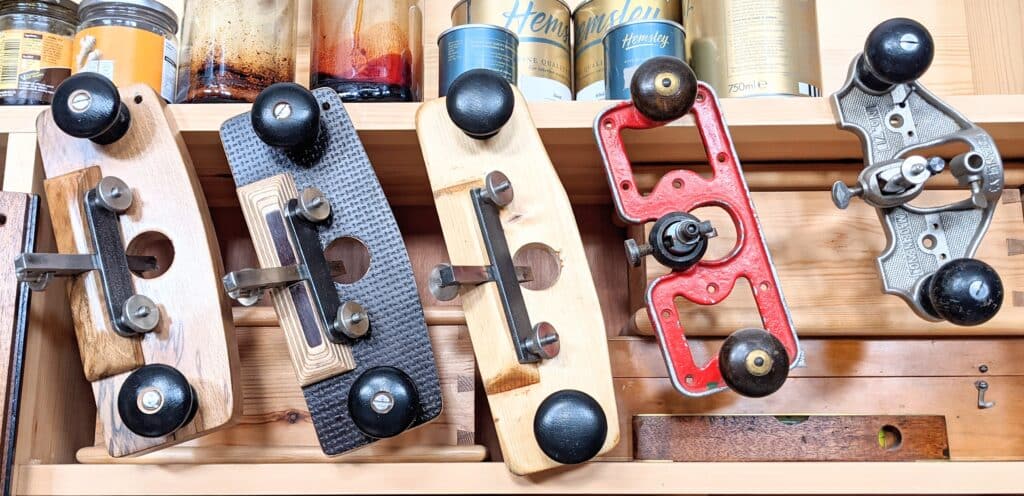
So, the table design has flex. It can be round or square, octagonal or indeed elliptical too — maker’s choice. Simple designs like this fill the gaps in the floor space of any room you care to name. A bedside table, a lampstand, plantstand, cup space near to hand and readily moveable, to anywhere your guests are sitting, and with just a single hand. I have enjoyed finding the gaps and discussing them with my inner man to see what the consequences are between the round, square, rectangular, oval, octagonal considerations. Then there are the rounded corners, rounded edges, rounded legs to think through too. Oh, and I am thinking of painting the wood to colour too. I like brights like reds and blues, yellows and purples. The colours float from one to the other in my head and, faster than any computer can ever produce, my mind makes the shift and I see them in multidimensional realness right there in my brain changes.
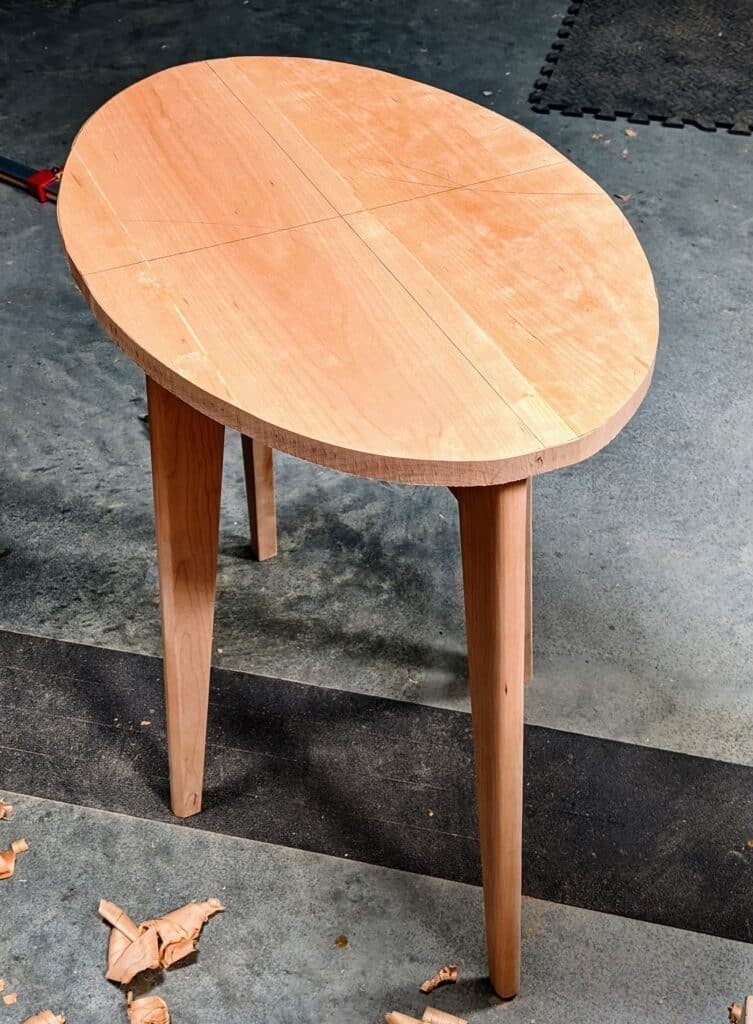
The nuts and bolts of making are just the smallest part of designing. We should truly consider how our brain is working and steering us automatically towards a particular way of doing what we do, and, can we make a conscious delivery of an alternative possibility outside of our comfort zone. I am truly surprised how much some people cannot leave an edge square or sloped or simply and gently rounded to round or oval and must install a Roman ogee, an astragal or an ovolo without even knowing where the idea came from that tells the world it was done by a powered router and today is ‘unhand‘ made. The undersides of my tables have plane marks left by the slight scallop one or two of my hand planes make. They are part of the story and the history my life and work will yet become. I might leave in my work marks as part of my story. The chopped mortises don’t come from the set depths of a mortise-machine stop dialed into the machine’s mechanism, but a mark on the side of my chisel; too simple! There is no quick succession of circles from the mortise machine bits burning their little circles at the mortise bottom. I like the subtle steps I leave from my chisel tip that will be there in 150 years when someone restores what I have made and says to his colleague or coworker (these terms that now replace buddy and mate, pal), ‘Hey, look at this, these were hand-cut mortises! His work is really nice and look how he used a super-sharp chisel to make it.’ I have learned far more from old craftsmen by searching their work for telltale signs than any human I worked alongside. The walls of the mortise, the chiseled corner left dead square or angled, these tell me so much about their work and how I should work. I can even tell how much pressure they were under to produce in the day.
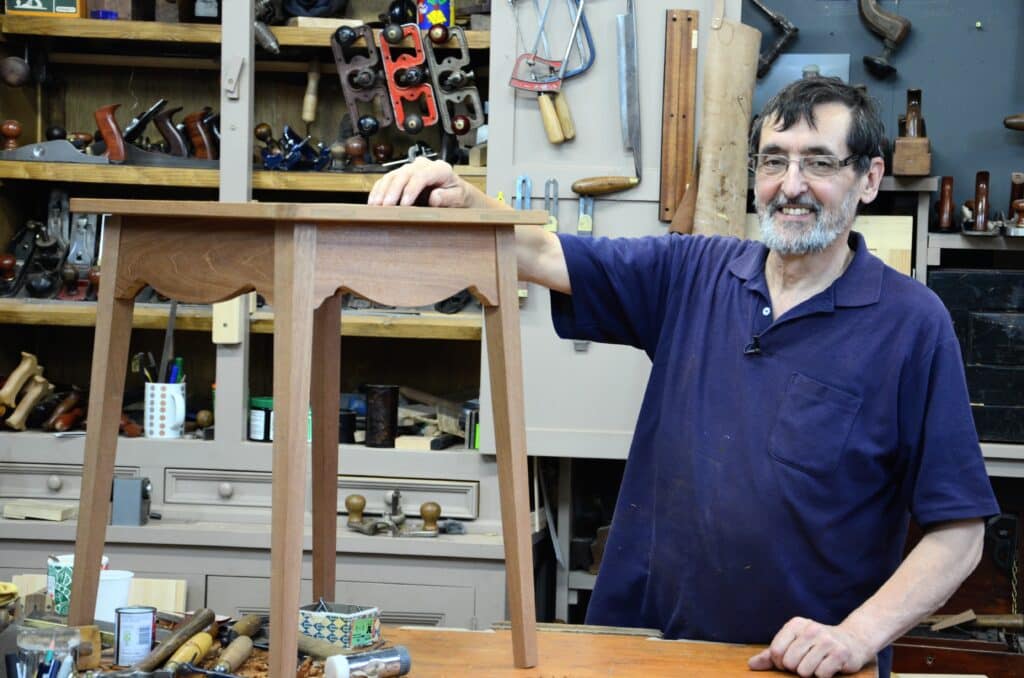
It takes eight minutes to chop a 3 1/2″ mortise 3/8″ wide and 1 1/4″ deep in cherry, including the haunch. I have 32 minutes for the mortises in my table and six minutes in the half housings. Then the tenons take twice as long because they do and they must then be fitted to slide smoothly into the relative mortise holes. No matter that they are usually not interchangeable because I mark them to be married to each mortise hole. Repetition is all part of the work I do. I make one, finish it and start another. Modernists laugh at me and even mock me. It’s bound to be so because they don’t know what I feel when I use skill to make, draw, think and design. I am influenced by all things and I make my decisions according to what has and is informing me. Inform means to form in. We see something that attracts us and inspires us and we file it in our minds for later use and later allow it in our designs and our methods of working. I think machines cut nearer to perfection than handwork with hand tools does. Even though this then has become skilless work, it is admired by those who never knew true art. Painting by number and colouring in the lines laid is never to be admired unless it is done by a three-year-old. I know! It’s explosive to say such things, but it is a reality that machine work has replaced skilled workmanship in most realms and a CNC router can never replace the qualities I can get in both mind and hand by using my body to work the tools that go with the sure and positive art and craft of the hand maker.
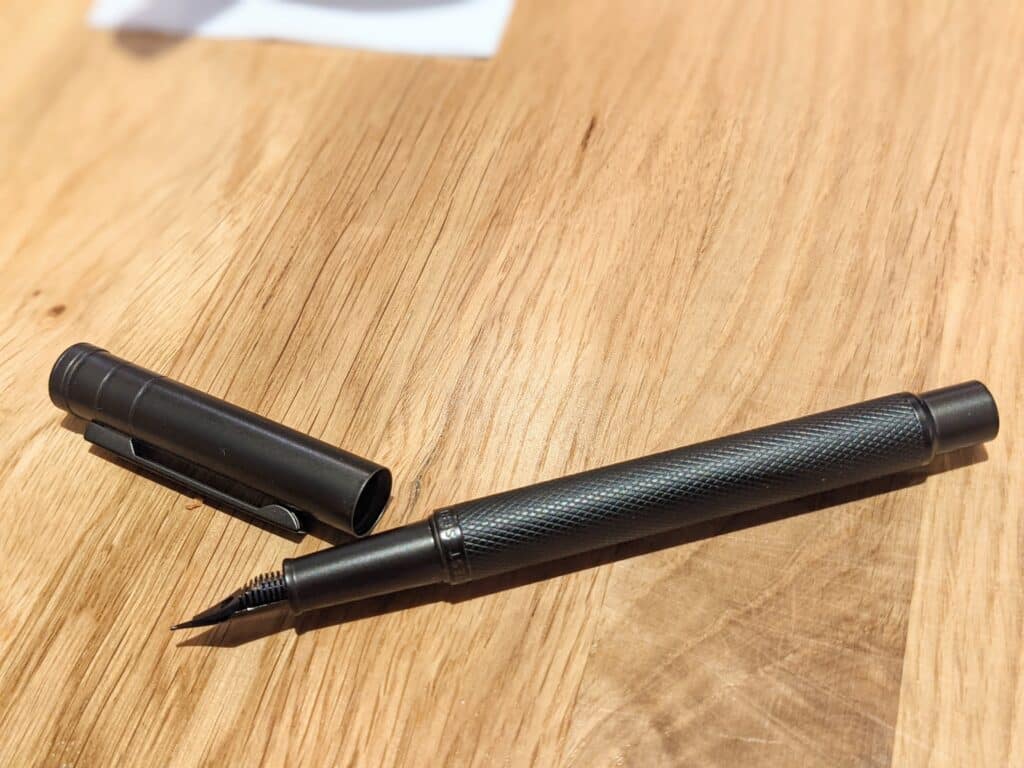
This, for me at least, is and always has been the true power of hand-making anything. It does not mean that I don’t or cannot admire a pen that is made by machine in China that sells for £15 that writes more smoothly than a vintage Shaefer or Waterman costing hundreds of pounds. Do I forsake the benefits of a good pen or wait until I `can afford a £200 pen?
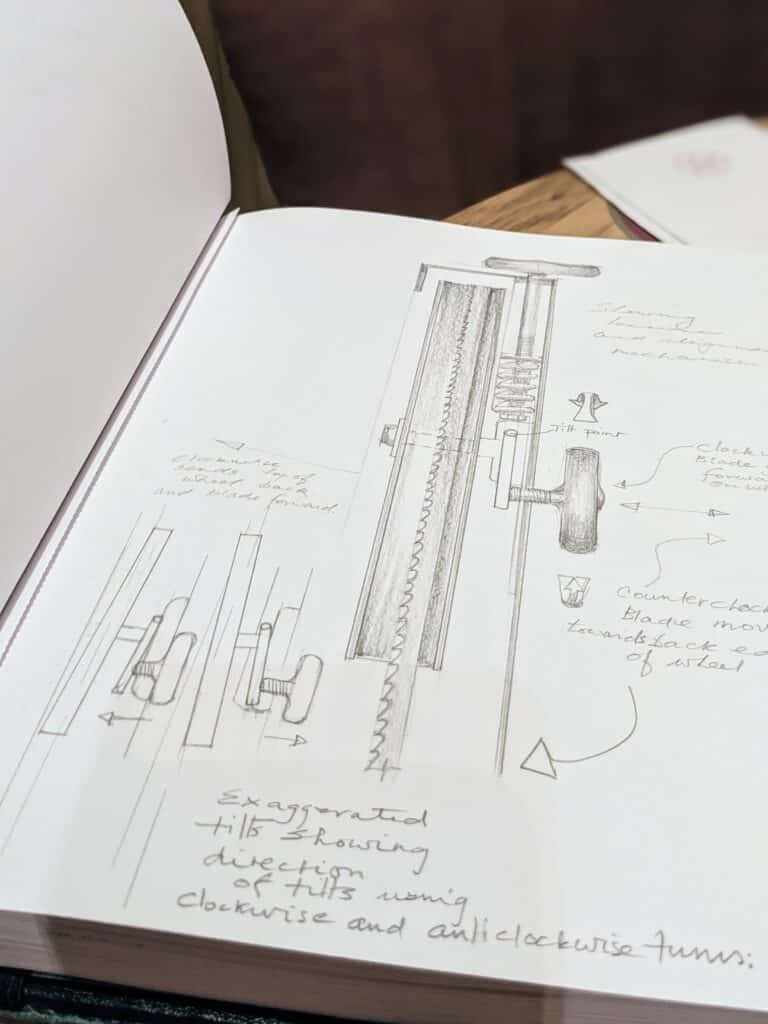
And then there is the art of writing too. Did you know that I write 2,000 words every single day and that many of my passages begin in a plain-page journal written with a fountain pen and drawn with a #2 graphite pencil? Is it because I am 71 and haven’t entered the technical/digital era? You judge! I type all of my blogs, usually a couple of thousand words, daily, from my written notes but often directly.
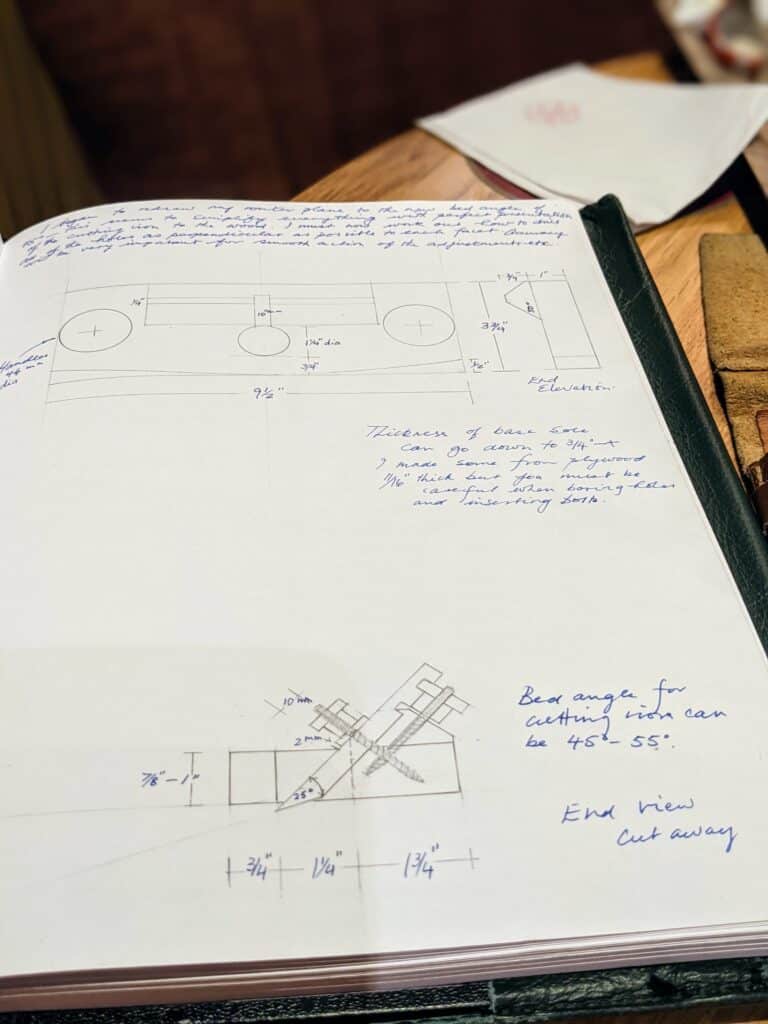
I like the way they float on the page as though my hands typing are detached from my body. But who can deny the deep, deep value of the flow of fresh blue ink on a white page? I could never achieve such a thing with a ball-point pen nor even a pencil because the fountain pen floats on the ink as the pen point touches the pages. This beauty cannot be described and it comes from a pen made in China that never clogs nor drips nor leaks and is made throughout from metal, not plastic yet feels light in my fingers as I write. Why do I not use a British Parker? I haven’t found one that works that well yet and I do not know where they are made anyway. Those that might suit me are expensive.
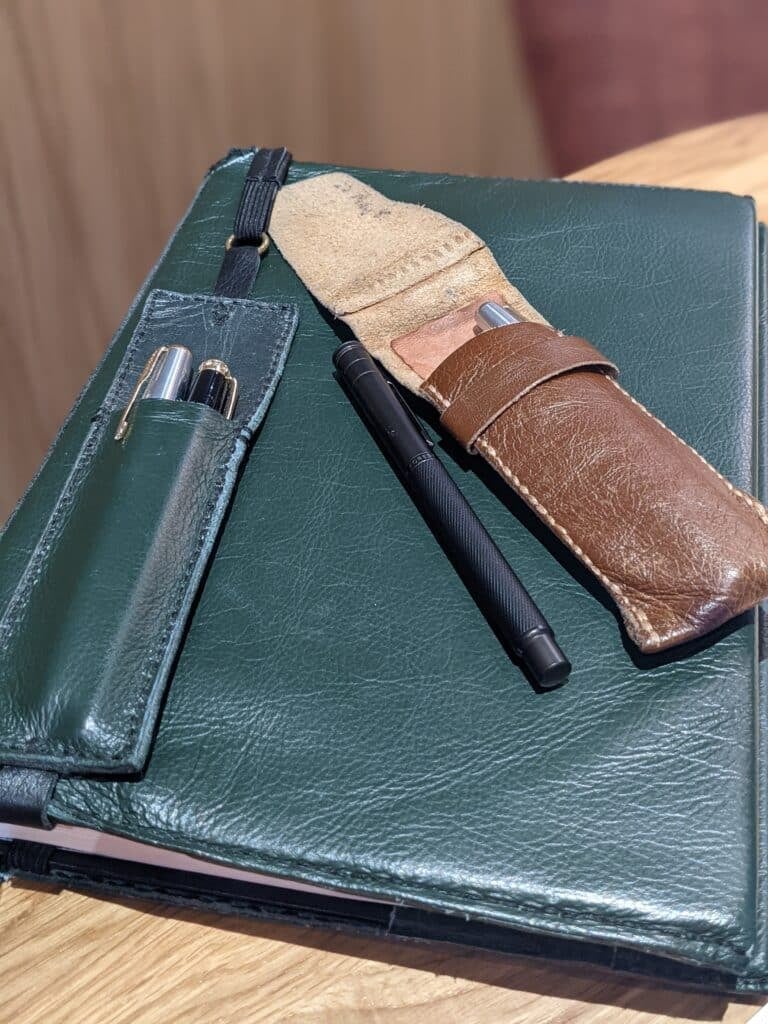
A saw I just bought to see a few close details on is the Crown 10″ gent’s saw I have used for two decades, the smaller one you see me using in most of my videos. In the advert description it says made in China yet it looks exactly like the one I bought all those years ago. On the saw plate, it says ‘Sheffield’ and ‘England’! What on earth does this mean. Was it par-made in China and assembled back in Sheffield by the distributor? Who can tell? If they can send live hogs from the USA to China for killing and processing and send it back to the US as rashers to escape FDA ruling they can surely send other things to and from other continents to cheapen all the more by cheapened labour, that is nothing new. Look what giants like Stanley do in the USA by having tools made to the south of their borders down in Mexico, or Nicholson files, for that matter. The advantaged can do these things. Maybe after Covid, this will change. Who knows? Governments like the UK are now investing heavily in what they once sold to other continents: apprenticeships and manufacturing. The problem? Those highly trained and skilled makers who were made redundant over a half-century period that left the gap of working knowledge by skilled artisans. Oh well!
So anyway, back to my mortise holes, trimming tenons and fitting them rightly but not too tightly. When I’ve done, the world will be right again and let it vote as it will.
Good Sunday morning everyone! Hope that your day is as good as it can get.


Can’t wait to see the price of fountains pens now. You have way too much influence. Lol
Truth!
How can I buy this magnificent pen? I would love to buy it and try it
Best!
Patrick
[email protected]
Look on the internet for fountain pens under $26 dollars. I found it with a one-minute search.
this comment actually made me laugh after the grim feeling that was growing in me after having red this beautifull and true text of Paul.
Thank you Sir.
Thanks Paul.
Do you have any other tools you are planning to make and show us how?
You might find this funny. One of my early ambitious pieces was a nightstand for my daughter. It was challenging for me as I lacked the skills at the time I made it. I stuck with it though and it came out nice. However, many of the joints were looser than I would have liked. On one of the tenons, I wrote a brief apology “sorry, I am a beginner” so that that when it is repaired/restored they will understand.
I really love this! However, after seeing some really bad tenons in the family’s professionally-made chairs and tables, I’d probably consider yours not that bad, after all.
That’s a Hongdian Black Metal Fountain Pen. Very nice.
1966, DePaul College of Law, Professor Anderson who taught contracts from his textbook for maybe half a century, advised: Now, you lawyers-to-be, go out and buy yourself a bound briefing book and a good fountain pen (not a ballpoint pen), a fountain pen and let the law just pour out. Lol. I did. 🙂
Hi Paul,
Your drawings are inspiring and apologies if this has already been provided: have you made a “guide” for beginners to learn how to make precise design drawings like you do?
Thank you
I haven’t, Lets. Perhaps I could. Hmm!
I think that’s something most of us are expecting, it would very very good. I thought you would be doing that with the Sellers Home projects.
As a young man I had pretty amazing artistic skills. I could sketch very detailed tools that looked nearly photographic quality, but time and exposure to too many nasty chemicals over the years put an end to that. My hands began shaking from the nerve damage some time ago. Pretty much the same for my former beautiful penmanship. Now I’m not much better than my folks who by all accounts “couldn’t draw a straight line with a ruler.” This all makes me appreciate your own artistic skill that much more. I used to have the same feel for it.
To add..Now I can type pretty fast and considering buying an old fashioned mechanical typewriter.. I miss those old machines and the quality that went into them.
The drawings are beautiful little works of art! A well executed drawing will often reveal more about its subject than a photograph can.
I have seen something before but cannot remember if it’s on youtube or woodworking masterclasses.
Hello Paul,
I wanted to dismantle a chair to repair one of the joints. Is it possible to get the (what looks like animal glue ) joints apart by some method ?
Steam heat can often work if you can get it in the joint. A steam iron or steamer of some kind, clothes steamer, wallpaper stripper???. It will spoil the existing finish, so that has to be evaluated.
Thank you for the advice. The finish is awful and needs re applying in shellac so I will give one of these a go.
Danny Blom of Blom Guitars outside of Nashville, TN uses a cappuccino machine to remove a damaged neck from an existing guitar. The cappuccino machine would work for that kind of disassembly, too. Alternative: An old-fashioned Presto pressure cooker. Instead of putting a weight on the steam exhaust, use heavy surgical tubing, insulated well, to bring the steam to the joint.
Dear Mr Sellers,
I am starting to make your router plane, mmm, no suitable wood to hand. Now what? wait a minute, all those logs in the wood shed, I found one large enough to rip down and give me all the pieces needed but, how dry does it need to be?
I have a moister meter ( I do not like burning unseasoned wood) which tells me its dry enough to burn but, is it enough to make into your gift to the world?
regards
John.
Maybe cut oversize, weigh it, keep it for a few days, and weigh it again to see if it lessens by much.
I’m curious as to what fountain pen is featured, that you refer to. Can you tell me what make it is? Kind regards, Alasdair Munro
Please let us know how to purchase one of those Chicom pens.
Every diy tool is a chip in the big boys prpfits Industrial slavery makes the world of commerce profitable. An injury to one is an injury to all. #IWW
Great post! I too love using a fountain pen in my leather journal. Can’t beat it. Thank you for all your instructional videos. So helpful and very inspiring.
As soon as Paul sellers gives the name of that pen it will triple in price 😁
Hi Paul, I did find painting by numbers quite therapeutic when I had both my arms in plaster from a fall many years ago. Just stuck a brush in the cast and supported it with what fingers could be seen poking out! Still look back with fondness at my 10 days with you ( and Phil and John) at the castle in 2014 – I learnt so much, and still do from your on-line work.
Hi Paul, your a man of many talents but just wounded in your long career have you done any furniture restoring or conservasion ?
I have indeed, substantive amounts in my time, yes.
Would you ever consider sharing your knowledge in some way, or is that a step to far.
Paul, I am not sure what your question is and what I am not doing. It’s just possible that I am missing something.
Hi Paul, sorry for not explaining properly. Just wondered if maybe adding to your agenda the possibilities of may be some simple furniture restoration of conservation projects. you do such a fantastic job explaining all the aspects of wood working, it’s such a shame nobody with good old experience (like yourself) covers this topic in your brilliant style. Many regards.
Paul.
Using your hands in conjunction with your head is one of those things that integrates us. Even as you age “keeping your hand in” is simply good for you. One of my hobbies is flint knapping, which I took up as a means of understanding archaeological materials (I’m an archaeologist). As you build understanding of the materials and process, you discover that that same understanding permeates more than the simple activity your are engaged in. Paul’s views are well worth studying. I like pencil for sketching myself, but that is because pens have always tended to run away on me. The friction between the tip and paper doesn’t seem to resist my hand properly. But I keep trying.
Hi Paul, I bought your pen online just based on your photo, it’s lovely. I also got a bottle of ink. It’s nice to be able to fill the pen directly from the bottle which I have never done.Now I just need to find a nice journal. Thanks!
I just buy Barnes and Noble sketchbooks called punctuate black basic ISBN -13:978-064158603-3